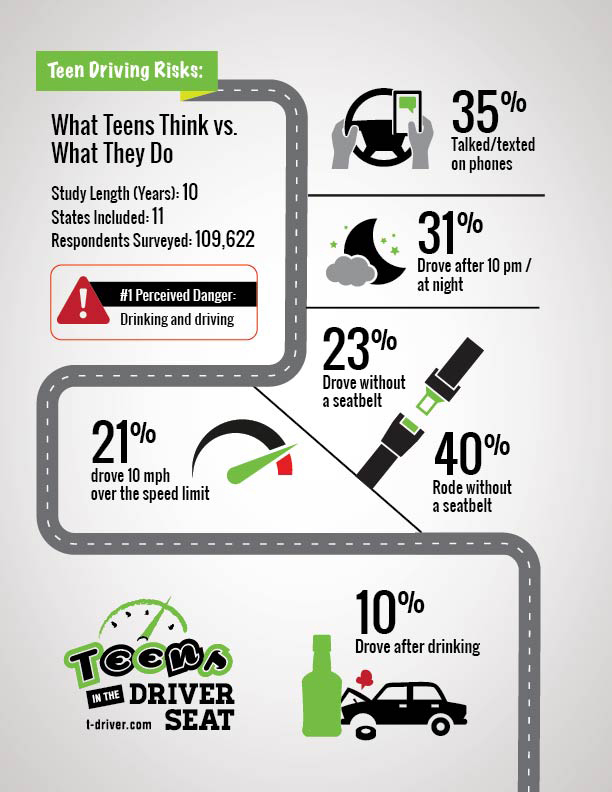 Teen drivers understand that texting and talking on their cell phones are among their most dangerous behaviors behind the wheel, but they admit to doing them anyway. That’s one of the findings from the Teen Driver Risk Awareness Survey conducted by the Texas A&M Transportation Institute (TTI).
Teen drivers understand that texting and talking on their cell phones are among their most dangerous behaviors behind the wheel, but they admit to doing them anyway. That’s one of the findings from the Teen Driver Risk Awareness Survey conducted by the Texas A&M Transportation Institute (TTI).
The survey — one of the largest of its kind and conducted through TTI’s Teens in the Driver Seat® (TDS) program over a 10-year period from 2007 to 2016 — received responses from 109,622 teen drivers in 11 states: Texas, Georgia, North Carolina, Nebraska, Connecticut, California, Colorado, Oklahoma, New Mexico, New York and Pennsylvania.
“Our analysis sought to determine what teenagers perceive to be the most dangerous aspects of driving and compare those to the risky behaviors they’re actually exhibiting behind the wheel, either driving or riding in a car, in the 30 days prior to taking the survey,” TTI Associate Transportation Researcher Lisa Minjares-Kyle explains. She presented the survey’s findings at the 62nd Annual American Driver and Traffic Safety Education Association in Rosemont, Illinois, July 23.
“The insights from this TTI study are very valuable and help all of our safety partners hone our messages and outreach as we continue to work together in our state and nation to address this ongoing challenge of young driver behavior,” says Texas Department of Transportation (TxDOT) Traffic Safety Section Director Terry Pence. Funding from TxDOT’s Section 402 program helped TDS get started in 2002.
All teens participating in the survey attended high schools that have implemented TDS, a peer-to-peer, traffic-safety program designed to teach teen drivers about the five most dangerous behaviors associated with riding or driving in a car: distractions, driving at night, speeding and street racing, not wearing a seat belt, and driving under the influence.
“The contrast between awareness and behavior is consistent with several other studies on this topic,” says Russell Henk, founder of TDS and manager of TTI’s Youth Transportation Safety Program. “As this new school year begins, the survey reminds us why TDS is so important in motivating young people to influence one another to drive more responsibly.”
Respondents identified drinking alcohol as the most dangerous perceived crash risk factor. Yet, based on the dangerous activities they admitted, drinking and driving was among the least reported.
“The respondents told us that talking on their phones and texting while driving were among the most dangerous activities they could do. However, about 35 percent of the teens admitted to doing both either “some” or “a lot” over the previous 30 days,” Minjares-Kyle says.
Among the other findings from the survey, 23 percent of teen respondents admitted to driving without a seatbelt (more than 40 percent said they didn’t wear a seatbelt as a passenger), 21 percent admitted to speeding, and 16 percent said they ran a red light. A little more than 10 percent said they drove after drinking alcohol.
“We know teen drivers are at greater crash risk and are distracted easily when they have lots of friends with them while driving,” Minjares-Kyle explains. “Yet many don’t recognize their peers as distractions to driving and nearly 50 percent self-reported riding and driving with peers, more than any of the other behaviors.”
Researchers determined some differences in responses based on gender. Males most often perceived drinking, texting, phone use, speeding, and failure to wear a seat belt as top risks, while females cited drinking, phone use, talking, music and eating as the most dangerous. | View the White Paper at https://tti.tamu.edu/documents/TRB-1801857.pdf
“Today teens are facing a growing number of distractions including technology and fellow passengers. State Farm has a long history of advocating auto safety and promoting driver safety behind the wheel,” says Felicia Van Frank of State Farm Public Affairs. State Farm is a principal partner of TDS, helping to fund, among other things, TDS materials distributed in schools at no charge to the schools themselves. “Partnerships with organizations like Teens in the Driver Seat promote peer-to-peer messages between young drivers about prioritizing safety while driving.”